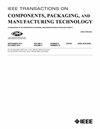不同热界面材料连接液冷金属泡沫的热性能
IF 3
3区 工程技术
Q2 ENGINEERING, ELECTRICAL & ELECTRONIC
IEEE Transactions on Components, Packaging and Manufacturing Technology
Pub Date : 2025-04-17
DOI:10.1109/TCPMT.2025.3561801
引用次数: 0
摘要
本研究采用三种不同的热界面材料(TIMs),通过实验和计算研究了具有相同孔隙/英寸(PPI)但不同孔隙率的金属泡沫(MFs)在均匀加热表面上的对流换热性能。在考虑的三种TIM中,由于其高面内导热性,与不使用TIM的参考情况相比,柔性石墨的传热性能最佳,约为10%-25%。相比之下,热环氧树脂是最差的,与参考情况相比,传热减少了约10%-30%。热隙垫具有与参考案例相当的性能。从压降数据中提取MF水力建模参数,并通过微CT ($\mu $ CT)扫描获得孔隙和细丝直径,并将其用于数值模拟。通过数值模拟计算了接触热阻。结果表明,总TCR随长丝直径的增大和孔隙率的减小而增大。此外,稳态热分析表明,柔性石墨有效地分散了TIM中的热量,降低了整体TCR。本文给出了热隙垫和不同孔隙率的柔性石墨薄膜加热表面的详细温度曲线来支持这些发现。本文章由计算机程序翻译,如有差异,请以英文原文为准。
Thermal Performance of Liquid-Cooled Metal Foams Attached Using Different Thermal Interface Materials
This study experimentally and computationally investigates the convection heat transfer performance of metal foams (MFs) having the same pores per inch (PPI) but different porosities attached to a uniformly heated surface using three different thermal interface materials (TIMs). Of the three TIMs considered, flexible graphite showed the best heat transfer performance by around 10%–25% compared to the reference case, where no TIM was used, due to its high in-plane thermal conductivity. In contrast, thermal epoxy was the worst, with a decrease in heat transfer by around 10%–30%, relative to the reference case. A comparable performance to the reference case was exhibited by the thermal gap pad. The MF hydraulic modeling parameters were extracted from the pressure drop data, and pore and filament diameters were obtained from micro-CT ( $\mu $ CT) scans and used in the numerical simulations. Thermal contact resistances (TCRs) are assessed from the numerical simulations. The results showed that total TCR tends to increase with increasing filament diameter and decreasing porosity. Moreover, the steady-state thermal analyses showed that the flexible graphite effectively spreads the heat in the TIM and reduces the overall TCR. Detailed temperature contours on the heated surface of the thermal gap pad and flexible graphite TIMs used with different porosity MFs are presented to support these findings.
求助全文
通过发布文献求助,成功后即可免费获取论文全文。
去求助
来源期刊

IEEE Transactions on Components, Packaging and Manufacturing Technology
ENGINEERING, MANUFACTURING-ENGINEERING, ELECTRICAL & ELECTRONIC
CiteScore
4.70
自引率
13.60%
发文量
203
审稿时长
3 months
期刊介绍:
IEEE Transactions on Components, Packaging, and Manufacturing Technology publishes research and application articles on modeling, design, building blocks, technical infrastructure, and analysis underpinning electronic, photonic and MEMS packaging, in addition to new developments in passive components, electrical contacts and connectors, thermal management, and device reliability; as well as the manufacture of electronics parts and assemblies, with broad coverage of design, factory modeling, assembly methods, quality, product robustness, and design-for-environment.
 求助内容:
求助内容: 应助结果提醒方式:
应助结果提醒方式:


